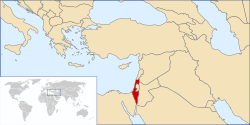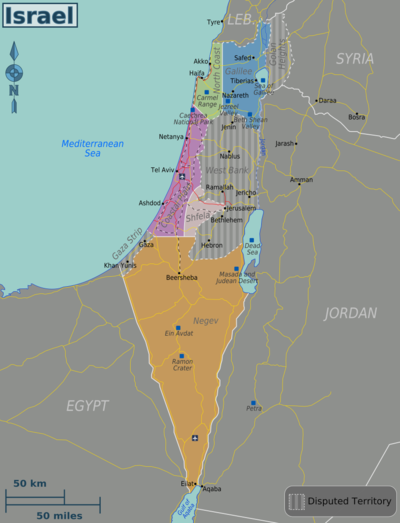![]() Click here to see the map of the area in full screen.
Click here to see the map of the area in full screen.
| Location | |
 | |
| Fast Data | |
| Capital city | Jerusalem |
| State | Presiding parliamentary democracy |
| Coin | shekel (ILS) |
| Area | 20,770 sq.m. km |
| Population | 8.982.200 |
| Language | Hebrew, Arabic |
| Religion | 74.8% Judaism, 17.6% Islam, 2% Christianity, 1.6% Druze, 4% no religion |
| Calling Code | 972 |
| Internet TLD | .il |
| Time zone | IST (UTC 2), daylight saving time (UTC 3) |
The Israel is her country Middle East.
At a glance
Israel was created in 1948 as the homeland of Jews around the world. The country is at war due to internal (Palestine, occupied territories) and external frictions (general hostility of the Arab states with which it was or is at war) and special attention is paid to security issues. Travel to Israel can be for either commercial or tourist purposes, but for Jews and Christians it is also a pilgrimage to the Holy Land.
Israel is generally a lowland country. It has several fertile plains, mainly in the northern part called Galilee.
The mountains of the country are Meron (1,208 m) to the north, Carmel, Tabor and the hills of Judea and the Negev desert. The snow-capped Mount Hermon (2,244m) in the Golan Heights has been annexed by Israel but under international law is Israeli-occupied Syrian territory. It is the only ski resort in Israel. Southern Israel is the Negev Desert, which is more than half the size of the country.
Israel has only one remarkable river, the Jordan (320 km long). The largest lake is the Dead Sea, named because of the lack of aquatic life, which is due to the high salt content of its waters. It is located 394 m. Below sea level and its depth reaches 400 meters. The only notable freshwater lake in the country is that of Galilee, which the Israelites call Kinneret, also known as Tiberias.
Appropriate visit period
Israel's climate is Mediterranean near the sea, with very hot summers and short, mild winters. In the hills of Jerusalem -as well as in the occupied West Bank- it gets colder and sometimes it snows. In the south the climate is much drier and there is a desert.
Languages
In the region of Israel (not Palestine), the official language spoken is Hebrew. In Palestine, people speak mainly Arabic.
Areas
Israel has a number of different regions, with landscapes ranging from coast, mountain, plain and desert landscape, with almost everything in between. Apart from cities and towns, each region of Israel has its own unique attractions. Its metropolitan areas Jerusalem and Tel Aviv are treated as separate areas, from north to south, however, the areas of Israel are as follows:

| Galilee (Galilee) This area can be divided into the hills of Upper Galilee and Lower Galilee, as well as the Israel Valley and Sea of Galilee. |
| North coast of Israel (Israeli North Coast) Sometimes called "Western Galilee", this area stretches along the Mediterranean coast from Haifa in the Ross Hannigra and the Lebanese border. Also includes Carmel area. |
| Israeli coastal plain (Israeli Coastal Plain) The most developed part of Israel, between the Carmel region and the Gaza Strip. The area north of it Tel Aviv she is known as Sharon. |
| Sfela (Shfela) The fertile, hilly hinterland between the coastal plain and the highlands of Judea. |
| Negav (Negev) Desert covers a large part of southern Israel. It also includes the Israeli part of it desert of Judea and Dead Sea |
| Hills of Jerusalem (Jerusalem hills) a mountainous region in central Israel that includes, inter alia, the western part of Jerusalem. |
Disputed territories
| Golan Heights (Golan Heights) Mountainous area northeast of Sea of Galilee. Occupied since 1967 by Israel, to which it annexed unilaterally in 1981. The annexation of the Golan Heights is not recognized by the United Nations. Israeli law applies in the area. |
| West Bank and Gaza Strip Two separate natural soils, the West Bank east of the Jordan River and the Gaza Strip to the southwest along the shores of the Mediterranean. It is not internationally recognized as part of any country - Judea and Samaria (West Bank) receive government services (security, medical services, etc.) from Israel, the Palestinian Authority, or a combination, depending on the exact location as a result of the agreement of Oslo, the Hamas-controlled Gaza Strip. |
Important cities
- Jerusalem. —
- Tel Aviv. —
- Haifa. —
- Elat. —
- Bethlehem. —
- Extensions (Yes). —
- Nazareth. —
- Tiberias. —
- Ber Seva. —
- Safed. —
Additional destinations
How to get there
By air
Israel's main airport is Ben Gurion International Airport in Tel Aviv. Travelers should make sure (especially if traveling alone) to be at least three hours in advance of check-in due to the strict security controls. Be prepared for incredible detail control of your personal belongings and questions about you and your trip.
By train
By road
By boat
How to move
Israel has a very good railway network. Trains pass by the stations two or three times an hour. Tel Aviv has three train stations.
Taxis are a very common means. It is advisable for the traveler to insist on the use of the taximeter from the beginning of the race (preferably) or to agree on the cost of the trip (if he knows the average cost well). Taxi drivers are very likely to cause a problem at the end of the route by demanding a larger amount than usual if the taximeter has not been used or an agreement has not been reached.

